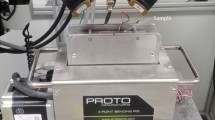Abstract
The paper presents an adaptive method for inverse determination of the tensile \(\sigma -w\) relationship, direct tensile strength and Young’s modulus of cementitious materials. The method facilitates an inverse analysis with a multi-linear \(\sigma -w\) function. Usually, simple bi- or tri-linear functions are applied when modeling the fracture mechanisms in cementitious materials, but the vast development of pseudo-strain hardening, fiber reinforced cementitious materials require inverse methods, capable of treating multi-linear \(\sigma -w\) functions. The proposed method is fully general in the sense that it relies on least square fitting between test data obtained from various kinds of test setup, three-point bending or wedge splitting test, and simulated data obtained by either FEA or analytical models. In the current paper adaptive inverse analysis is conducted on test data obtained from three-point bending of notched specimens and simulated data from a nonlinear hinge model. The paper shows that the results obtained by means of the proposed method is independent on the initial shape of the \(\sigma -w\) function and the initial guess of the tensile strength. The method provides very accurate fits, and the increased number of variables describing the \(\sigma -w\) relationship constitutes the basis for obtaining detailed information of crack propagation in any cementitious material.

















Similar content being viewed by others
References
Barenblatt GJ (1962) The mathematical theory of equilibrium cracks in brittle fracture. Adv Appl Mech 7:55–129
Dugdale DS (1960) Yielding of steel sheets containing slits. J Mech Phys Solids 8:100–104
Hillerborg A, Modéer M, Petersson PE (1976) Analysis of crack formation and crack growth in concrete by means of fracture mechanics and finite element. Cem Concr Res 6:773–782
Petersson PE (1981) Crack growth and development of fracture zone in plain concrete and similar materials. Ph.D. Dissertation, Report TVBM-1006, Division of Building Materials, Lund Institute of Technology
Gopalaratnam VS, Shah SP (1987) Tensile failure of steel fiber-reinforced mortar. J Eng Mech 113:635–652
Cornelissen HAW, Hordijk DA, Reinhardt HW (1986) Experimental determination of crack softening characteristics of normal and lightweight concrete. Heron 31:2
Roelfstra PE, Wittmann FH (1986) Numerical method to link strain softening with failure of concrete. Fracture toughness and fracture energy of concrete. Elsevier, Amsterdam
Kitsutaka Y (1995) Fracture parameters for concrete based on poly-linear approximation analysis of tension softening diagram. Fracture mechanics of concrete structures. In: Wittmann FH (ed) Proceedings FRAMCOS-2
Kitsutaka Y (1997) Fracture parameters by polylinear tension-softening analysis. J Eng Mech 123:444–450
Uchida Y, Kurihara N, Rokugo K, Koyanagi W (1995) Determination of tension softening diagrams of various kinds of concrete by means of numerical analysis. Fracture mechanics of concrete structures. In: Wittmann FH (ed) Proceedings FRAMCOS-2, pp 17–30
Uchida Y, Barr BIG (1997) Tension softening curves of concrete determined from different test specimen geometries. Fracture mechanics of concrete structures. In: Mihashi H, Rokugo K (eds) Proceedings FRAMCOS-3, pp 444–450
Østergaard L (2003) Early-age fracture mechanics and cracking of concrete: experiments and modelling. Ph.D. Dissertation, Department of Civil Engineering, Technical University of Denmark
Østergaard L, Olesen JF (2004) Comparative study of fracture mechanical test methods for concrete, Fracture mechanics of concrete structures. Li V (ed) vol 11 IA-FraMCoS, USA, pp 455–462
Sousa JLA, Gettu R (2006) Determining the tensile stress-crack opening curve of concrete by inverse analysis. J Eng Mech 132:141–148
Slowik V, Villmann B, Bretschneider N, Villmann T (2005) Computational aspects of inverse analysis for determining softening curves of concrete. Comput Methods Appl Mech Eng 195:7223–7236
Skocek J, Stang H (2008) Inverse analysis of the eedge-splitting test. Eng Fract Mech 75:3173–3188
Ulfkjær JP, Brincker R, Krenk S (1990) Analytical model for moment-rotation curves if concrete beams in bending fracture behavior and design of materials and structures. In: Firrao D (ed) Proceedings 8th conference on Fracture-ECF8, Engineering Materials Advisory Services LTD, vol 2, pp 612–617
Ulfkjær JP, Krenk S, Brincker R (1995) Analytical model for fictitious crack propagation in concrete beams. J Eng Mech 121:7–15
Pedersen C (1996) New production processes, materials and calculation techniques for fiber reinforced concrete pipes. Ph.D. Dissertation. Department of Structural Engineering and Materials, Technical University of Denmark
Stang H, Olesen JF (1998) On the interpretation of bending tests on FRC materials. In: Mihashi H, Rokugo K (eds) Proceedings FRAMCOS-3, fracture mechanics of concrete structures, vol I, Aedificatio Publishers, Freiburg, Germany, pp 511–520
Stang H, Olesen JF (2000) A fracture mechanics-based design approach to FRC. In: Proceedings of the 5th Rilem Symposium on Fiber-Reinforced Concretes (FRCs), BEFIB
Olesen JF (2001) Fictitious crack propagation in fiber-reinforced concrete beams. J Eng Mech 127:272–280
Löfgren I, Stang H, Olesen JF (2005) Fracture properties of FRC determined through inverse analysis of wedge splitting and three-point bending tests. J Adv Concr Technol 3:423–434
Löfgren I (2005) Fibre-reinforced concrete for industrial construction: a fracture mechanics approach to material testing and structural analysis. Ph.D. Dissertation, Chalmers University of Technology
RILEM-TC-162-TDF (2002) Design of fiber reinforced concrete using the \(\sigma -w\) method: principles and applications. Mater Struct 35:262–278
Author information
Authors and Affiliations
Corresponding author
Rights and permissions
About this article
Cite this article
Jepsen, M.S., Damkilde, L. & Lövgren, I. A fully general and adaptive inverse analysis method for cementitious materials. Mater Struct 49, 4335–4348 (2016). https://doi.org/10.1617/s11527-015-0791-3
Received:
Accepted:
Published:
Issue Date:
DOI: https://doi.org/10.1617/s11527-015-0791-3




